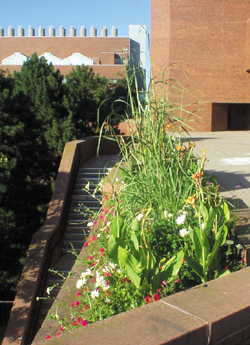Splashes of Color on Campus

A refurbished planter in the wall outside Wheatley Hall overflowing with flowers.
August 29, 2002
During Michael Dukakis’ presidential campaign in the mid-1980s, his wife Kitty Dukakis paid a visit to the UMass Boston campus. Mrs. Dukakis commented on the nice brickwork and ample green space. But she also mentioned the lack of color throughout the harbor campus.
Jim Allen, the director of the Biology Department’s greenhouses told this story amidst the chatter of parakeets and cockatiels in the greenhouse workshop. He also said that similar comments about how un-vibrant our campus is have been repeated for years. However, thanks to Allen, his five student employees, and the UMB grounds staff, critics of our supposedly colorless campus have something new to talk about.
When Chancellor Jo Ann Gora came to UMB in 2001, she visited the Biology Department greenhouses, which are located on the 4th floor of the Science Building. According to Allen, Gora was “wowed” by the plants.
Gora’s reaction is not too surprising. Anyone who makes the trip to the greenhouses would be impressed at what they hold. The greenhouse boasts three different growing environments, a workshop for planting and transplanting, and a rooftop deck which holds larger plants and overflow.
One growing environment is devoted to rain forest and tropical plants, another for plants which require slightly less humidity, and a third for cacti and some plants being used for experiments by biology students at the university.
The collaboration between the greenhouse and grounds staffs has resulted in several color splashes blooming campus wide.
One focus area for Allen was the shuttle bus stop behind the Administration Building. He said that he wanted to make that area look nice because so many people access the university by public transportation.
Beginning in March, flowerbeds were installed by a contractor in the median strip on University Drive. Those beds were later supplemented with plants from the greenhouse.
“It’s been very challenging to garden in that spot,” said Allen. He went on to explain that the growing conditions on University Drive and at Fox Point are less than ideal. The proximity to the water ensures an almost constant breeze, and the flat concrete and asphalt make the areas almost desert-like.
“The flowerbeds still thriving are doing so because of diligent watering,” Allen said. The watering is no easy task, but the greenhouse and grounds staffs accomplish it.
How? By filling up a giant bag with water and delivering it to different parts of the campus to water the plants. But Allen assures that any watering difficulty is not because of the drought our area has been experiencing this year. It has more to do with the lack of plumbing in or near some of the new plantings. He also mentioned that the water restrictions in our area have never gone past the voluntary stage. Allen is concerned about the drought, and to keep people informed, he has linked the greenhouse’s web page (http:// greenhouse.bio.umb.edu) to a UMass Amherst drought watch.
In February of this year, Allen attended a conference called “New England Grows”, a showcase of regional suppliers and garden centers. It was there that he received a dozen plug trays each holding 105 plants from the Massachusetts Growers Association. Plug trays are large plastic trays that house dozens of tiny seedlings. Allen gladly accepted the donations and went to work.
After months of careful growing it was time to transplant the pansies, petunias, and other flowers to their new homes campus wide.
It was at that point that the university grounds staff became instrumental in the plans as well. Grounds superintendent Bob Kelly and his staff prepared many of the areas for the plants: sweeping, mowing, clearing. They also renovated the planters on the edge of Wheatley Hall for the greenhouse staff to fill them up with plants.
Overall, this piece of campus beautification has cost the university very little money, because much of the plant material was donated or grown here on campus. Allen estimates that the university only spent about $1,000 on plant material, in addition to purchasing seven new ornamental Bradford pear trees.
The color that has been added with these plants may not last through the winter though. The tall orange and red plants, cannas, are tropical and have no chance of making it through a New England winter without the help of a greenhouse. Those plants will be transplanted back to the greenhouse for the winter months so they can be used again when the warm weather returns.
Most of the plants in the new beds that provide color are annuals, meaning they have to be replaced each year, which Allen intends to do. The rest are perennials and are mostly green: ornamental grasses, bayberry bushes, and buddlea, a drought tolerant plant.
If the fall and early winter are mild though, at least one of the annuals, the pansies, could make it through the winter. Don’t be fooled by their name, Allen says, they are actually quite hardy, and have braved the dry weather and winds very well.
Although this first bunch of plantings have been pretty successful, Allen is not completely satisfied. “This is just a beginning,” he said, “because there are a lot of areas on this campus that could be beautified.”





















































